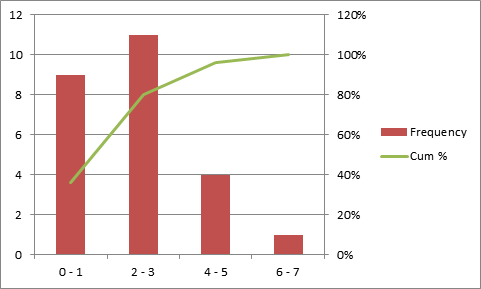
- #MAKE A HISTOGRAM IN EXCEL FOR MAC 2017 HOW TO#
- #MAKE A HISTOGRAM IN EXCEL FOR MAC 2017 UPGRADE#
- #MAKE A HISTOGRAM IN EXCEL FOR MAC 2017 CODE#
- #MAKE A HISTOGRAM IN EXCEL FOR MAC 2017 SERIES#
This is easily corrected by formatting any one of the bars, and changing the Overlap property to 100%. It’s not quite right, though, since it’s a clustered bar chart, and each visible bar is clustered with four blank values. The chart now shows five sets of colored bars, one for each data range of interest. This is easily done by dragging and resizing the colored highlights. We need to change the source data, removing column B and adding columns C:G. When the bar chart is selected, the chart’s source data is highlighted as shown. The formula is filled into the range C4:G13. The formula shows the value in column B if it falls between the limits in rows 1 and 2 otherwise it shows an apparent blank. The formatting limits are inserted into rows 1 and 2. The header formula in cell C3, which is copied into D3:G3, is =C1&" Our data ranges from 0 to 10, and we will create series for each of the ranges 0-2, 2-4, 4-6, 6-8, and 8-10. We will replace the original plotted data in the line and bar charts with several series, one for each set of conditions of interest. In the same way, we will use formulas to define the formatting of series in the charts. Except for some simple built-in formats, conditional formatting of worksheet ranges requires formulas to determine which cells should take on the formatting. We want our charts to show different colored points depending on the points’ values. The data makes a simple unformatted bar chart. Here is the simple data for our conditional chart formatting example. The following technique works very well without resorting to macros, with the added advantage that you don’t have to muck about in VBA. This can be done using VBA to change the individual chart elements (for example, VBA Conditional Formatting of Charts by Value), but the code must be run whenever the data changes to maintain the formatting. People often ask how to conditionally format a chart, that is, how to change the formatting of a chart’s plotted points (markers, bar fill color, etc.) based on the values of the points. Conditional formatting of charts is a different story. Here is the process replicated for the Mac.It’s relatively easy to apply conditional formatting in an Excel worksheet. It’s a built-in feature on the Home tab of the Excel ribbon, and there many resources on the web to get help (see for example what Debra Dalgleish and Chip Pearson have to say). Example for Excel for Mac 2011Įach version of Excel will require slightly different instructions, but the technique will largely be the same. You can adjust and customize your graph as needed. At the top toolbar select Add Chart Elements and add the axis labels.īy following these directions, you should now see your data represented through the basic histogram graph. By now you should be looking at something like this.ġ0. Right Click on one of the Bars and select Format Data Series… from the drop down menu.Īffinity photo offer. By now you should have something that looks like this. Selecting these options in prior versions of Excel without the ribbon toolbar will appear different.ħ. Click on Insert Column Chart, and select Clustered Column, from the 2-D Column Section. In my example, I have selected cells A1 through B7.Ħ. Once you have your raw data into Excel, select your data. In the Intervals and Frequency columns input your data.Ĥ. On the horizontal x-axis will be the intervals data which may also be called groups, segments, or bins. Histograms most often deal with intervals and frequency. Title the A1 and B2 column Intervals and Frequency accordingly. At the end of the article, for example, see an example of these steps for Excel for Mac 2011.Ģ. Excel 2007, 2010, and 2011 for Mac all have tested using this technique. The screenshots and directions presented here are from Excel 2013 however, previous versions of Excel can easily create histogram through these same methods. The instructions here are for Excel 2013, but histograms can be created in prior versions of Excel in a similar fashion. Spectrum essay book in english pdf.Ī histogram graph is used to graphically demonstrate the distribution of data within Excel. To upgrade to Excel 2016 you can use this link here: Microsoft Office 2016. In this example I show you how easy it is to insert a Histogram Chart using Excel 2016. They are very visual as it can easily show you the distribution of numerical data, like seeing which numerical ranges are the most common. Histogram Charts are one of the many new Charts available only in Excel 2016. Posted Octoby Alex Bahdanovich in Microsoft Excel#MAKE A HISTOGRAM IN EXCEL FOR MAC 2017 SERIES#

#MAKE A HISTOGRAM IN EXCEL FOR MAC 2017 CODE#
#MAKE A HISTOGRAM IN EXCEL FOR MAC 2017 HOW TO#

#MAKE A HISTOGRAM IN EXCEL FOR MAC 2017 UPGRADE#


 0 kommentar(er)
0 kommentar(er)
